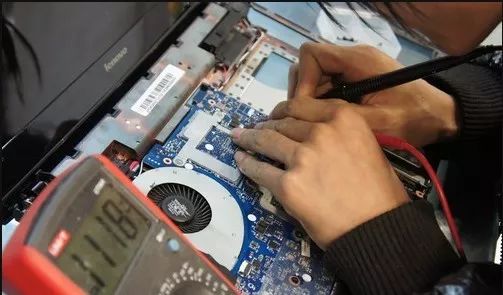
1. Faults Caused by Capacitor Damage
Capacitor damage is the most common fault in electronic devices, particularly with electrolytic capacitors.
Signs of capacitor damage include: reduced capacitance; complete loss of capacitance; leakage; short circuit.
Different capacitors serve various roles in a circuit, leading to distinct fault characteristics. In industrial control circuit boards, digital circuits dominate, with capacitors mainly used for power filtering, while those used for signal coupling and oscillation circuits are less common. If an electrolytic capacitor in a switching power supply is damaged, the power supply may fail to oscillate, resulting in no voltage output; or the output voltage may not be filtered properly, causing voltage instability and logical confusion in the circuit, which manifests as the machine working intermittently or failing to start. If the capacitor is between the positive and negative terminals of the power supply in the digital circuit, the fault will present similarly.

This is particularly evident on computer motherboards, where many computers start showing issues after a few years, sometimes failing to boot and sometimes working. Upon opening the case, one can often see bulging electrolytic capacitors. If one removes the capacitor and measures its capacitance, it is often found to be significantly lower than the rated value.
The lifespan of a capacitor is directly related to the ambient temperature; the higher the temperature, the shorter the lifespan. This rule applies not only to electrolytic capacitors but also to other types of capacitors. Therefore, when searching for faulty capacitors, one should focus on those located close to heat sources, such as near heat sinks and high-power components, as the closer they are, the higher the likelihood of damage.
I once repaired a power supply for an X-ray flaw detector, where the user reported smoke coming from the power supply. Upon opening the case, I found a large capacitor (1000uF/350V) leaking a substance resembling oil. After removing it and measuring its capacitance, I found it to be only a few tens of uF. It was also noted that this capacitor was the closest to the heat sink of the rectifier bridge, while others further away were intact and had normal capacitance. Additionally, I found ceramic capacitors that had shorted, and they too were located near heat-generating components. Thus, focus is essential when troubleshooting.
Some capacitors leak significantly, becoming hot to the touch; these must be replaced.
When troubleshooting intermittent faults, after ruling out poor connections, most issues are typically caused by capacitor damage. Therefore, when encountering such faults, it is advisable to focus on checking capacitors; replacing them often yields surprising results (of course, one should also consider the quality of the capacitors, opting for reputable brands like Rubycon or Nichicon).
2. Characteristics and Identification of Resistor Damage
Many beginners often struggle with resistors during circuit repairs, removing and soldering them repeatedly. However, with experience, understanding the damage characteristics of resistors can save a lot of effort.
Resistors are the most numerous components in electrical devices, but they are not the ones that fail most often. Resistor failures are most commonly open circuits, with resistance increasing being less common and decreasing resistance being very rare. Common types include carbon film resistors, metal film resistors, wire-wound resistors, and fusible resistors.
The first two types are the most widely used, with damage characteristics including a higher failure rate for low resistance (below 100Ω) and high resistance (above 100kΩ), while mid-range resistances (hundreds of ohms to tens of kilohms) rarely fail; low resistance failures often show burn marks, making them easy to identify, while high resistance failures usually leave no visible traces.
Wire-wound resistors are typically used for high current limiting, with low resistance values. When cylindrical wire-wound resistors fail, some may show blackening or surface cracking, while others may show no signs. Cement resistors, a type of wire-wound resistor, may break when burnt, otherwise showing no visible signs. Fusible resistors may show surface damage, but will never burn or blacken. Based on these characteristics, one can prioritize their inspection of resistors to quickly identify failures.
With the characteristics listed above, we can first observe if there are any burn marks on low resistance resistors on the circuit board. Then, based on the fact that most resistor failures are open circuits or increased resistance, and that high resistance resistors are prone to failure, we can use a multimeter to measure the resistance across high resistance resistors on the circuit board. If the measured resistance is higher than the rated value, that resistor is definitely damaged (note that the reading should stabilize before concluding, as there may be parallel capacitive components in the circuit that require a charge and discharge process). If the measured resistance is lower than the rated value, it is generally not a concern. By measuring each resistor on the circuit board, even if we mistakenly identify a thousand, we won’t miss one.
3. Methods for Judging the Quality of Operational Amplifiers
Judging the quality of operational amplifiers can be quite challenging for many electronic repair technicians, not only due to educational background (I have many undergraduates who, without teaching, would not understand, and even those taught take a long time to grasp; there’s also a graduate who specifically studied variable frequency control, yet struggles with this too!). I hope to share some insights that may help.
An ideal operational amplifier has the characteristics of “virtual short” and “virtual open,” which are very useful for analyzing linear applications of operational amplifier circuits. To ensure linear operation, the op-amp must work in a closed-loop (negative feedback) configuration. Without negative feedback, the open-loop op-amp becomes a comparator. To determine the quality of the device, one must first understand whether it is being used as an amplifier or as a comparator in the circuit.
Regardless of the type of amplifier, there is a feedback resistor Rf; thus, during repair, we can check this feedback resistor on the circuit. Using a multimeter, measure the resistance between the output and the inverting input. If the resistance is excessively high (above a few MΩ), we can reasonably conclude that the device is being used as a comparator. If this resistance is lower (0Ω to tens of kΩ), we should check for any resistors connected between the output and the inverting input; if so, it is definitely being used as an amplifier.
According to the principle of virtual short in amplifiers, if this operational amplifier is working correctly, the voltages at the non-inverting and inverting inputs must be equal, with any difference being in the millivolt range. Of course, in some high input impedance circuits, the internal resistance of the multimeter may affect the voltage measurement slightly, but it generally should not exceed 0.2V. If a difference of more than 0.5V is detected, the amplifier is undoubtedly faulty!
If the device is being used as a comparator, differences between the non-inverting and inverting inputs are acceptable.
If the voltage does not conform to this rule, the device is definitely faulty!
Thus, you do not need to use substitution methods or remove chips from the circuit board to judge the quality of the operational amplifier.
4. A Tip for Testing SMT Components with a Multimeter
Some SMT components are very small, making it inconvenient to test them with standard multimeter probes; this can easily cause short circuits, and it is difficult to contact the metal parts of the component leads on insulated circuit boards. Here’s a simple method that can greatly facilitate testing.
Take two of the smallest sewing needles, and attach them to the multimeter probes. Then, take a thin copper wire from a multi-strand cable, and bind the probes and needles together with it, securing them with solder. This way, when using the fine-tipped probes to test SMT components, there is no risk of short circuits, and the needle tips can pierce through the insulating coating, directly accessing critical areas without the hassle of scraping off the coating.
5. Troubleshooting Short Circuit Faults in Common Power Supplies on Circuit Boards
When repairing circuit boards, encountering short circuit faults in common power supplies can be daunting, as many components share the same power supply, making each component suspect of shorting. If there are not many components on the board, using a “broad search” approach can eventually locate the short circuit point. However, if there are too many components, luck plays a significant role in finding the issue. I recommend a very effective method that can quickly identify fault points.
Acquire a power supply that can adjust both voltage and current, with a voltage range of 0-30V and a current range of 0-3A; this power supply is inexpensive, around 300 yuan. Set the open-circuit voltage to the supply voltage level of the components, starting with the current set to the minimum. Apply this voltage to the power supply points of the circuit, such as the 5V and 0V terminals of 74 series chips, and gradually increase the current while monitoring the components. When you touch a component that feels significantly hot, that is often the damaged component, which can then be removed for further measurement. Of course, during operation, the voltage must not exceed the component’s working voltage, and connections must not be reversed, or other good components may be damaged.
6. A Small Eraser to Solve Big Problems
With the increasing use of industrial control boards, many boards employ golden fingers that insert into slots. Due to harsh industrial environments—dusty, humid, and corrosive gases—these boards often develop contact faults. Many friends may have resolved issues by replacing boards, but the cost of purchasing new boards can be quite substantial, especially for certain imported devices. Actually, you might try using an eraser to clean the golden fingers a few times; after cleaning the dirt off, you may find that the problem is resolved! This method is simple and practical.
7. Analyzing Intermittent Electrical Faults
Intermittent electrical faults can generally be categorized into the following situations based on probability:
1. Poor Connections
Poor contact between the board and the slot, internal breaks in cables that cause intermittent connectivity, poor contacts in plugs and terminals, and cold solder joints are all included in this category;
2. Signal Interference
For digital circuits, faults may only manifest under specific conditions, possibly due to excessive interference affecting the control system, or due to changes in the parameters of individual components or overall performance, leading to reduced interference immunity and resulting in faults;
3. Poor Thermal Stability of Components
From extensive repair experience, the primary concern is the poor thermal stability of electrolytic capacitors, followed by other capacitors, transistors, diodes, ICs, and resistors;
4. Moisture and Dust on Circuit Boards
Moisture and dust can conduct electricity, exhibiting resistance effects. Moreover, during thermal expansion and contraction, resistance values may change, which can have a parallel effect with other components, significantly altering circuit parameters and causing faults;
5. Software as a Consideration
Many parameters in circuits are adjusted using software. If some parameters are set too close to their limits, when the machine operates under conditions that meet the software’s fault criteria, alarms may trigger.
Welcome to Contribute to Discuss the Development of the Home Appliance Service Industry!
Likes are a form of encouragement, sharing spreads friendship. 